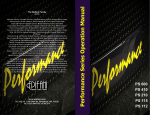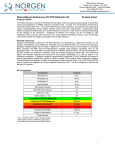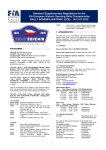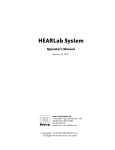Download Epifani UL 115 Combo Instruction manual
Transcript
Instruction Manual Ultra Light Series • 502 Amplifier • 902 Amplifier • Quest II Preamp • UL 112 Combo • UL 210 Combo • UL 115 Combo • Table of Contents Introduction .................................................... 2 INNOVATE • EVOLVE • INSPIRE Ultra Light Series Important Safety Information.......................... 3 Front Panel Features ....................................... 4 Rear Panel Features ........................................ 5 Getting Started................................................ 6 Connections .................................................... 6 Powering Up ................................................... 7 Dialing In Your Sound ..................................... 7 • 502 Amplifier Routing ........................................................... 7 • 902 Amplifier Rear Panel Operation ...................................... 8 • Quest II Preamp • UL 112 Combo • UL 210 Combo • UL 115 Combo Specifications.................................................. 9 Epifani Family................................................ 10 Speakers and Accessories ............................ 11 • Welcome! Welcome to the Epifani family of owners and thank you for your purchase. Our sole mission is to design innovative products that inspire musicians of all skills and styles to challenge their creative boundaries. It’s really very simple - to play your best you need to sound your best. We hope you enjoy your Epifani investment and, should you ever need service, you can feel confidant that we put as much pride in supporting our products as we do designing and building them. Love the way you sound! -- Nick Epifani 2 • Epifani Ultra Light Series Since 1992 the Epifani design team has been working very closely with many of the world’s leading bassists, developing what are regarded as some of today’s finest and most rewarding bass amplification systems. We are dedicated to research and development, constantly evolving innovating, and hopefully, inspiring in the process. All Epifani products are designed to meet the needs of the working & traveling musician. Portability, tone, weight, and size do matter. We focus on real-world needs, and strive to deliver practical products that embody superior form and peerless function. When we design we evaluate every aspect of the project: size, wood type, construction techniques, cabinet tuning, speaker quality, electronic components, weight, versatility etc., but the most important element is the musicality of the finished product. The products need to “sing”, and the defining moment for us is when our customers experience music without thinking or worrying about their gear - they just play. In 2001 we introduced our Ultra Light Series speaker cabinets. Combining superior performance and less weight than a traditional bass instrument cabinet, Epifani Ultra Light cabinets have become the standard of excellence in bass cabinet design since their inception just a few short years ago. Made from uncommonly strong, yet lightweight Italian Poplar, the UL Cabinets employ an internal bracing design that would make a traditional cabinet too heavy for one person to handle. This material allows for a sturdier cabinet construction, more precise cabinet tuning, and further reduces sound-damaging resonance. Loaded with high performance neodymium drivers built to demanding specifications specifically for Epifani, the cabinets are tuned to reveal the true nature and nuance of your instrument’s character. Even the crossovers are made from the highest quality components - the best polypropylene capacitors, 18 gauge inductors and sealed 1/4” phono/Neutrix Speakon™ connectors. The cabinets are finished in heavy-duty fabric and protected by high-impact plastic corners for years of sustained use and abuse. The UL Series Heads from Epifani represent an important step in the evolution of professional bass amplification. Utilizing a proprietary class “D” amplifier, the UL Series Heads were designed for the power, precision and clarity today’s professional bassists demand. The unique, 2-channel pre-amp design allows the user to toggle between two separate foot switchable channels, employ dual instrument inputs and access a foot switchable mid-cut feature for killer slap tone on demand! Other features include a three-band equalizer with sweepable midrange, pre-amp mute and treble shift. Welcome to the world of Epifani… • Unpacking Your Unit IMPORTANT NOTE: Your Epifani product was originally packaged in a specifically designed carton and included special packing materials. Please save these items - they should be used when shipping your Epifani product. Please inspect the shipping carton - if the packaging seems damaged, please return this item to the shipper. 3 • WARNING/CAUTION WARNING: TO REDUCE THE RISK OF FIRE OR ELECTRIC SHOCK, DO NOT EXPOSE THIS APPARATUS TO RAIN OR MOISTURE. CAUTION: TO REDUCE THE RISK OF FIRE OR ELECTRIC SHOCK, DO NOT REMOVE THE COVER. NO USER SERVICABLE PARTS INSIDE. REFER SERVICING TO A QUALIFIED PROFESSIONAL. WARNING RISK OF ELECTRIC SHOCK DO NOT OPEN The lightning flash with arrowhead symbol within an equilateral triangle is intended to alert the user to the presence of uninsulated dangerous voltage within the product’s enclosure that may be of sufficient magnitude to constitute a risk of electric shock to persons. The exclamation point within an equilateral triangle is intended to alert the user to the presence of important operating and maintenance (servicing) in the literature accompanying this device. • Important Safety Instructions 1.) Read these instructions. 2.) Keep these instructions 3.) Heed all warnings. 4.) Follow the instructions. 5.) Don not use this apparatus near water. 6.) Clean only with a dry cloth. 7.) Do not block any ventilation openings. Install in accordance with the manufacturer’s instructions. 8.) Do not install near any heat sources such as radiators, heat registers, stoves, or other apparatus that produce heat. 9.) Do not defeat the safety purpose of the grounding type plug. A grounding type plug has two blades and a third grounding prong and is used for your safety. 10.) Protect the power cable from being walked on or pinched particularly at the plugs or at the point where they exit the device. 11.) Unplug this apparatus during lightning storms or when unused for long periods of time. 12.) Refer servicing to all qualified service personnel. Servicing is required when the apparatus has been damaged in any way, such as the power cable has been damaged or liquid has been spilled or objects have fallen into the apparatus or the apparatus has been exposed to rain or moisture, does not operate normally or has been dropped. 4 13.) Damage requiring service: Unplug the apparatus from the wall outlet and refer servicing to qualified service personnel under the following conditions. a) When the power supply cord has been damaged. b) If liquid has been spilled, or objects have fallen into the apparatus. c) If the apparatus has been exposed to rain or moisture. d) If the apparatus does not operate normally by following the operating instructions. Adjust only those controls that are covered by the operating instructions as an improper adjustment of other controls may result in damage and will often require extensive work by a qualified technician to restore the apparatus to its normal operation. e) If the apparatus has been dropped or damaged. 14.) When the apparatus exhibits a distinct change in performance this indicates a need for service. 15.) Object and Liquid entry: Never push any foreign objects of any kind into the openings as they may touch dangerous voltage points that could result in fire or electric shock. The apparatus shall not be exposed to dripping or splashing and no objects filled with liquids such as a beverage shall be placed on top. • Front Panel Features 1.) Passive Input – Input jack for a passive instrument. 2.) LED Channel Indicator & Peak Indicator – Indicates channel switching and gain limits. 3.) Channel 1 Gain – Adjusts the input signal to the appropriate level. 4.) Channel 1 Bass Control – Adjust the amount of low frequency 5.) Channel 1 Mid- Midrange Control – Adjusts the amount of midrange frequencies 6.) Channel 1 Treble Control – Adjusts the amount of high frequencies 7.) Channel 1 Mid-cut switch/w led – Eliminates specific midrange frequencies 8.) Power Switch – Turns the Amplifier on or off. 9.) Active Input – Input jack for an instrument with Active electronics. 10.) Ch1/Ch2 Selector – Switches between Channel 1 and Channel 2 (engaged either manually or via the footswitch). 11.) Channel 2 Gain – Adjusts the input signal to the appropriate level. 12.) Bass – Adjust the level accordingly to your preference. Start at the twelve o’clock position and add/ deduct, as you prefer. 13.) Channel 2 Parametric Midrange Level Control – This feature allows you to boost or cut a particular frequency chosen by the Mid-Frequency Control (14). * When the Level Control is set at 12 o’clock it is at “0” (it is neither boosting nor cutting any frequencies), therefore you will hear no difference when adjusting the Mid Frequency Control (14). 14.) Channel 2 Parametric Mid Frequency Control – This control allows you to select a center point frequency between 180 & 2000 HZ. – That bandwidth can be boosted or cut via the Mid Level Control (13). 15.) Channel 2 Treble Control – Adjusts the amount of high frequencies 16.) Channel 2 Treble Shift Selector – This feature “shifts” the treble frequency from 3 kHz to 6 kHz 17.) Master Mute Switch – Is engaged manually or via the optional footswitch. The Mute switch mutes the amplifier section but not the pre-amp section. 18.) Master Volume – Adjusts the overall output of the amplifier. 5 • Rear Panel Features *Balanced Out- (Quest II preamp only) - This XLR jack is a low noise output intended for use with an amplifier that has a balanced input. 19.) USA/European Power Select Switch – Select 120V for use in the U.S. Select 220V for European use. 20.) AC Line-in – Firmly plug the supplied AC power cable into the socket. 20b.) Fuse – The fuse protects the amplifier from damage due to line current faults, power surges etc... If the fuse blows replace it with the appropriate fuse. For 120V units replace with a 6.3A 250 Volt fuse, on 220 V units replace with a 3.15A 250V fuse. 21.) Amp Out with Speakon™ Connector – Connect your amplifier to the speaker cabinet using a Speak-On cable. NEVER connect plus or minus to ground – (i.e. we highly recommend the use of a “Speakon to Speakon” for a better connection. In the event of a Speakon to 1⁄4 inch connection be sure the connection from the amp to cabinet is made while the amplifier is OFF. 22.) Pedal Control – Allows you switch between Channel 1 and Channel 2 and toggle Mute/Tuner, and Mid-cut. 23.) Effect Send/Return – This feature allows you to use outboard effects with the Ultra Light Amp. Effects Send/Return - Can also be run in series or parallel via the selector switch (23). 24.) Tuner Out – Connect your tuner using an instrument cable. While in mute mode you can directly/silently tune. 25.) Preamp Out – Use this feature to bypass the power section of your Ultra Light 502/902 and use an alternate power amp. If you are using a Quest II preamp, connect your power amp input here using an instrument cable. 26.) Pre/Post EQ – Selects whether direct output (DI) signal comes before or after Ultra Light EQ section. 27.) Direct Out Level – Adjusts the signal coming from Direct Out (Usually kept at the twelve o’clock position). Adjust accordingly in conjunction with different applications (recording, live, etc.). 28.) Ground Lift – Disconnects chassis ground to get rid of unwanted hiss and buzzing. 29.) Direct Out (XLR) – Send a balanced signal to house sound or sound engineer (Can be also used as a “record out” for studio applications). 6 • Getting Started Now that you’ve become acquainted with the features of your new Epifani Amplifier it’s time to actually experience the product. To operate this product to it’s fullest potential please read these instructions thoroughly. WARNING! - BEFORE PLUGGING YOUR UNIT IN FOR THE FIRST TIME READ THE FOLLOWING SECTION CAREFULLY. AC outlet voltages vary from country to country. Make sure that the voltage in your area meets the voltage requirements printed on the apparatus (e.g., AC 230V 50 Hz or AC 120V 60Hz.) Make sure that the voltage selector is set in the proper position for your area. Failure to do so could result in harm to your amplifier and void the warranty. • Connections 1.) 2.) 3.) 4.) 5.) 6.) Remove the AC cable from the package and firmly insert the female end in the AC receptacle located on the back panel of your amp. With the amplifier in the “OFF POSITION” plug the male end of the AC cable into the wall outlet. Connect the speaker using either the “Speakon™ or 1/4” phone jacks on the rear panel. Make sure that you are using an “unshielded” speaker cable and that the polarity of the cable is correct. Do not use a shielded instrument cable to connect speakers to an amplifier. NEVER connect plus or minus to ground – (i.e. we highly recommend the use of a “Speakon™ to Speakon™” for a better connection. In the event of a Speakon™ to 1⁄4 inch connection be sure the connection from the amp to cabinet is made while the amplifier is OFF. Note - (If you’ve purchased an Epifani Combo amp the primary speaker connection has already been made.) Now you can connect your instrument to the amplifier. Make certain that you are using a “shielded” instrument cable to connect your instrument to your amplifier. If you are unsure of the type of cables you currently own, we advise you take a trip to your local music store and purchase the appropriate cables. If you have a passive instrument plug it into the jack marked “Passive” on the front panel. If you have an active instrument then plug it into the jack marked “Active” on the front panel. • Powering Up Before turning your amplifier on always set the “Master Volume Control” to the zero position. This will prevent damage to your speakers in the event of a product failure or faulty input signal. 1.) 2.) 3.) 4.) Turn the amplifier on using the power switch located in the upper right hand corner of the amplifier front panel. In the “on” position the indicator on the front panel should be illuminated blue. Upon power-up the mute feature will engage. Turn the volume on your instrument to the loudest position. Next, set the EQ controls (bass, mid, and treble) to zero (twelve o’clock position) and begin playing aggressively while turning up the Gain control of the appropriate channel (as indicated by the LED peak indicator light). When the LED light is green there is still potential to increase the Gain. When the light turns red your input is too hot and your signal will distort. For the cleanest sounding results, allow the LED indicator to turn red intermittently (only while playing at the most aggressive levels). Note: this must be done separately for both Channels 1 Channel 2. Next, turn the Master Control clockwise to the desired listening volume. Note: make sure the Mute button is not engaged. At this point you should be hearing your instrument amplified through the system. Congratulations! You’re only a few steps away from hearing your instrument’s true, natural character. 7 • Dialing in Your Sound Now you’re ready to utilize the studio quality EQ sections to really refine your sound. In general it is always better to cut or subtract EQ than to add EQ. When you cut unwanted frequencies you’ll decrease the overall volume of the system so, to compensate, you can simply turn up the gain to compensate. The EQ section of the Ultra Light Series 502, 902, and Quest II Preamp is null at the 12 O’clock position. So, unlike most amps, you have the ability to “add or deduct” frequencies for precise tonal preference. IMPORTANT: Whether you add or deduct EQ, you will have to readjust the Gain level. If you’ve added bass, mid, or treble you may have to decrease the Gain Level to avoid overdriving the input stage. If you’ve deducted bass mid or treble you may have to increase the Gain Level to achieve sufficient volume. Remember to look at the peak-input indicators for a reference. Channel 1 is equipped with our state of the art “Mid-Cut” Control. You can EQ this channel for a finger or pick style sound then engage the Mid Cut feature for a nice, scooped out slap tone. You essentially have 2 separate tones on this channel. Channel 2 is a bit different from channel 1, as it offers a semi-parametric equalizer and a unique Treble Shift option. The parametric section is intended to offer more precise control over any unwanted midrange frequencies. Use the Mid Frequency Control to select a frequency, and the Mid Level Control to boost or cut that particular frequency. If you are using this type of EQ for the first time some experimentation may be necessary for you to find “your sound”. To get familiar with this type of EQ select a frequency then boost that frequency range with the Mid Level control. While the Mid Level is boosted play your instrument while “sweeping” the Mid Frequency control (turning the control from left to right and back again). You’ll hear a dramatic change in the sound. Now repeat that process but instead of boosting the Mid Level, cut the level by turning the control counterclockwise. Play your instrument and “sweep” the Mid Frequency control. You’ll hear the frequencies you are sweeping cut from the sound of your instrument. By going through this process you will have become more familiar with frequencies impacted by the semi-parametric EQ and ultimately, find it easier to use this feature when creating a sound. Channel 2 also offers the “Treble Shift” button allowing you to fine-tune your sound even further. By engaging this button the treble will “shift” frequency position from 3000Hz to 6000Hz which can then be cut or boosted via the treble control. You’ll really notice the difference at the moment of attack or when you “pop” a string. • Routing Your Epifani amp offers one of the most unique routing features currently available on a bass amplifier. We’ve designed the amp to allow the user to access either channel 1 or channel 2 from either input. By plugging your instrument into either the appropriate input, you can access both channel 1 and channel 2 via the channel select button on the unit or by using the optional footswitch. This feature allows you to switch between different gain and EQ settings while performing. IMPORTANT: When you are plugged into the PASSIVE input and you switch channels, the input for the second channel also becomes PASSIVE. Likewise, when you are plugged into the ACTIVE input and you switch channels, the input for the second channel becomes Active. It is acceptable to plug an Active bass into the Passive input or visa-versa, but be sure to adjust the gain control accordingly (lower the gain when using an active bass in the passive input and increase the gain when using a passive bass in the active input). When two instruments are plugged into the amplifier at the same time, (one in the Active input and one in the Passive input), the inputs become isolated from one another. The Passive input goes to channel 1 and the Active to Channel 2. This allows you separate gain and EQ control for each instrument and the ability to switch between them while 8 playing (via the channel button or the optional footswitch). * This is particularly useful when using two instruments (in a live situation) that require different Gain sensitivity, or require different EQ settings. For example: an upright bass and an electric bass, or a fretted and fretless bass etc. No need to go “back to the amp” to adjust the settings for bass # 2! • Rear Panel Operation The rear panel of your Epifani amp has several useful features that, when used properly, will enhance the overall experience with your amp. 1.) Tuner out - Plug an instrument cable between this jack and your digital tuner. You can use the Mute Switch on the front panel to access the quiet tuning mode. Tuning quietly makes everyone around you happy and being in tune will help advance your career! 2.) Effect Send/Return - Using shielded instrument cables connect the “Effect send” to your effect’s input. Connect the output of your effect to the UL Amp Series “Effects Input”. Using the Serial/ Parallel switch you can choose run your effects “in line” with the dry signal or “along side” of the dry signal. Typically a reverb would be run in parallel and a chorus or flanger would be run in series. To practice along with pre-recorded music you could take the output of a tape player, CD player or MP3 player and plug it into the effect return jack. 3.) Pre-amp out - Using a shielded instrument type cable this output could be used to send a signal to a power amp or to send an unbalanced signal to a recording device. 4.) Direct Out - Using a “microphone” cable with XLR connectors you can send a balanced signal to the house PA or for direct injection into a recording device. 5.) Direct Out Level - You can control the volume of the Direct Out jack for the cleanest possible feed to an external device. 6.) Pre/Post switch - By placing the switch in the “pre” position you are essentially sending an unenhanced or “flat” signal out of the Direct Out. In the “post” position the Direct Out is outputting the EQ settings you have chosen. 9 • Specifications UL 502 Power Rating: 600w @ 4 ohms Weight: 16 lbs. Dimensions: 13” W x 11” D x 3” H (2 RU) Inputs: 1 Active, 1 Passive Signal to Noise Ratio: 90 dB Output Impedance: 4 ohms Input Impedance: Passive 470 Kohms, Active 200 Kohms UL 902 Power Rating: 750w @ 4 ohms Weight: 18 lbs. Dimensions: 19” W x 11” D x 3” H (2 RU) Inputs: 1 Active, 1 Passive Signal to Noise Ratio: 90 dB Output Impedance: 4 ohms Input Impedance: Passive 470 Kohms, Active 200 Kohms Quest 2 Pre-Amp Weight: 8 lbs. Dimensions: 13” W x 11” D x 3” H (2 RU) Inputs: 1 Active, 1 Passive Signal to Noise Ratio: 90 dB Input Impedance: Passive 470 Kohms, Active 200 Kohms UL 112 Combo Power Amp Rating: 600w @ 4 ohms Speaker Cabinet rating: 300w (can add extension speaker) Weight: 48 lbs. Dimensions: 19.5” W x 16.25” D x 21 1/2” H Inputs: 1 Active, 1 Passive Signal to Noise Ratio: 90 dB Output Impedance: 4 ohms Input Impedance: Passive 470 Kohms, Active 200 Kohms Speaker: 1 x 300w RMS Cast Aluminum Frame 100w RMS Tweeter Freq. Response: 43Hz - 16kHz Power Rating: 300w RMS (1200w Peak) UL 115 Combo Power Rating: 600w @ 4 ohms Weight: 58 lbs. Dimensions: 19.5” W x 16.25” D x 27.5” H Inputs: 1 Active, 1 Passive Signal to Noise Ratio: 90 dB Output Impedance: 4 ohms Input Impedance: Passive 470 Kohms, Active 200 Kohms Speaker: 1 x 400w RMS Cast Aluminum Frame 100w RMS Tweeter Freq. Response: 38Hz - 16kHz Power Rating: 400w RMS (1200w Peak) UL 210 Combo Power Rating: 600w @ 4 ohms Weight: 58 lbs. Dimensions: 19.5” W x 16.25” D x 27 1/2” H Inputs: 1 Active, 1 Passive Signal to Noise Ratio: 90 dB Output Impedance: 4 ohms Input Impedance: Passive 470 Kohms, Active 200 Kohms Speaker: 2 x 250w RMS Cast Aluminum Frame 100w RMS Tweeter Freq. Response: 40Hz - 16kHz Power Rating: 500w RMS (1200w Peak) 8 or 4 Ohms 10 • Speakers and Accessories Your newly purchased head was designed specifically for our innovative cabinets. If you don’t already own an Epifani speaker you may want to consider these options: UL 110 Speaker: 1 x 250w RMS Cast Aluminum Frame •100w RMS Tweeter • Freq. Response: 45Hz - 16kHz • Power Rating: 250w RMS (600w Peak) • 8 Ohms • Suggested Wattage: 100w - 500w • Sensitivity: 99dB SPL @ 1w 1m • Recessed Handles • 22 lbs. UL 112 Speaker: 1 x 300w RMS Cast Aluminum Frame • 100w RMS Tweeter • Freq. Response: 43Hz - 16kHz • Power Rating: 300w RMS (1200w Peak) • 8 Ohms • Suggested Wattage: 200w - 600w • Sensitivity: 100dB SPL @ 1w 1m Recessed Handles • 30 lbs. UL 115 Speaker: 1 x 400w RMS Cast Aluminum Frame • 100w RMS Tweeter • Freq. Response: 38Hz - 16kHz • Power Rating: 400w RMS (1200w Peak) • 8 Ohms • Suggested Wattage: 200w - 1000w • Sensitivity: 100dB SPL @ 1w 1m • Recessed Handles • 43 lbs. UL 210 Speaker: 2 x 250w RMS Cast Aluminum Frame • 100w RMS Tweeter • Freq. Response: 40Hz 16kHz • Power Rating: 500w RMS (1200w Peak) • 8 or 4 Ohms • Suggested Wattage: 200w - 1000w • Sensitivity: 102dB SPL @ 1w 1m • Recessed Handles • 38 lbs. UL 212 Speaker: 2 x 12” 400w RMS Cast Aluminum Frame • 100w RMS Tweeter • Freq. Response: 40Hz - 16kHz • Power Rating: 700w RMS (2100w Peak) • 8 or 4 Ohms • Suggested Wattage: 400w - 2000w • Sensitivity: 103dB SPL @ 1w 1m • Recessed Handles • 59 lbs. UL310 Speaker: 3 x 250w RMS Cast Aluminum Frame • 100w RMS Tweeter • Freq. Response: 40Hz - 16kHz • Power Rating: 750w RMS (1800w Peak) • 4 Ohms • Suggested Wattage: 200w - 1000w • Sensitivity: 103dB SPL @ 1w 1m • Recessed Handles • 47 lbs. UL 410 Speaker: 4 x 250w RMS Cast Aluminum Frame • 100w RMS Tweeter • Freq. Response: 40Hz 16kHz • Power Rating: 1000w RMS (2400w Peak) • 8 or 4 Ohms • Suggested Wattage: 400w - 2000w • Sensitivity: 103dB SPL @ 1w 1m • Recessed handles • 57 lbs. UL 610 Speaker: 6 x 250w RMS Cast Aluminum Frame •100w RMS Tweeter • Freq. Response: 40Hz - 16kHz • Power Rating: 1500w RMS (3750w Peak) • 4 Ohms • Suggested Wattage: 400w - 2000w • Sensitivity: 104dB SPL @ 1w 1m • Recessed Handles • 82 lbs. To get the most out of your new Epifani head or combo you’ll need the proprietary footswitch. This footswitch allows you select either channel 1 or channel 2, activate the “Mid Cut” feature or “Mute” the amplifier for quiet tuning. It hooks up to your amp with a standard microphone cable so length or availability of the cable will never be an issue. And of course you’ll need your Epifani gear wear. Just visit www.epifani.com for the latest in Epifani accessories and apparel. 11 • The Epifani Family Alphonso Johnson Joseph Sanchez Dave Beasley Anthony Jackson Kevin Jacoby (Cecilia) Joel Cataldo Antonio Righetti Lincoln Goines Brett Zadio Carlito Del Puerto Matthew Garrison Al Improta Carlos Del Puerto Mike Bendy Dominique DiPiazza Christian McBride Mike Pope Mark Dresser Dan Lakin (Lakland Basses) Oscar Cartaya (Spyro Gyra) Jon Bristol Daniel Vinec Oscar Stagnaro (Paquito De Rivera) Gary MacKenzie Darryl Jones (The Rolling Stones) Pepe Fabregues (Fabreques Basses) Anthony Wellington David Buda (Boston Pops) Pino Palladino Tony Lewis (Prologue) David Garcia Richard Bona Brian Barrett (thelowend.net) Greg Rzab (The Black Crowes) Ruben Rodriguez Rob DeSantis Steve Epstein (Velvet Jones Band) Andy Jordan Seth Meidenman Brent Pearen Joe Aranda Tony Mahone George Traviani Kern Brantley (Beyonce) Todd VanSelus (Ian McFeron Band) Maurice Fitzgearlod (Destiny’s Child) Daniel Pearson (Jessica Simpson/Taylor Dane) Vashon Johnson (Shania Twain/B.B. King) Lee Nadel (Carbondale) Eric Holden (Josh Groban) Frode Berg Jerry Barnes (Chic) Stanley Banks (George Benson) Malcolm Prescott John Benitez Steve Mosher (Moses Graphite) Luis Rivera Joe Gallant Steve Zerlin Bo Bradley Joe Lauricella (Fodera Guitars) Tony Garnier (Bob Dylan) Gabriel Nicholson (John Love) John Flitcraft Michael “Tiny” Lindsey (MichaelTolcher) Rashon Alexander Bernard Bell (Gap Band) Stacy McGee (Ginuwine) Lamont McCain (DJ Logic) Anthony Corley Bryant Wilder Drew Lustman Frank Speer Max Laredo Ole Gunnar EIkeland INNOVATE • EVOLVE • INSPIRE 68 34th St., Brooklyn, New York, USA Telephone 718-832-4664 • Fax 718-832-9250 www.epifani.com Copyright 2005, Epifani Custom Sound Dwayne Wright Sammy Sanfilippo Bernie Minoso Raul Bernal Tim Lyons Peter Falbo Philip Simmons Ryan Owens (Robbie Seay Band) Ivan Santiago Jin Kim C. Togbah Outland Stefan Held Jared Morante Jerome Gaw Ruben Austin Enrico Brazzale Kenneth J. Schweighardt JJ Plasencio Brian Buracker Ricardo Gil Martino “Hope” Vacca Cem Tuncer Josh Porter Joe Cambra Jonathan Floyd Jean-Yves BLaquiere Tom Szell Rick Van Benschoten JC Alza Bobby Turner Moises Maldonado Nick Lazarev Waldo Martínez David Swift (Jools Holland) Daniel Pearson (Taylor Dane / Clay Aiken) David Marotta (Top LA Session Bassist)




















